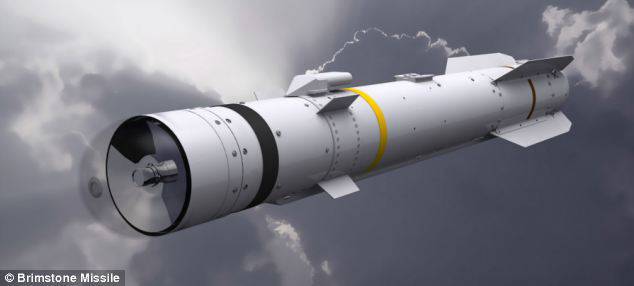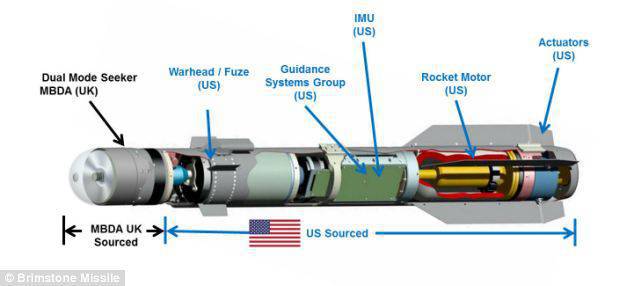Missiles of the MBDA Brimstone Family

In the early stages of development, the Brimstone guided missile (“Sulfur”) was considered as a modernized version of the American AGM-114 Hellfire missile, developed with regard to production in Europe. However, the design requirements for the project and the updating of various components of the munition led to the fact that the Brimstone project became independent. The AGM-114 rocket, previously considered the base one, borrowed only some common features of the face.
The first rocket of the family, Brimstone, has a starting weight of 48,5 and a full length of 1,8 meter with case diameter of 17,8 cm. A transparent fairing of the homing head and a semi-active laser system are located at the head of the ammunition. Behind the homing head in the case is a tandem cumulative warhead weighing 6,2 kg with a shock fuse, as well as control equipment. The tail part of the body is given under a solid rocket engine. On the side surface of the Brimstone rocket are two groups of X-shaped stabilizers, in the middle and tail parts of the body. Tail stabilizers are equipped with rudders for flight control. It should be noted that a similar arrangement of the units, as well as part of the onboard systems, was developed for the first Brimstone rocket, but is also used in its subsequent modifications. The main way to upgrade and improve ammunition was the replacement of some units with new ones with higher performance.
The control system of the Brimstone rocket is made in accordance with the concept of "shot-forget." For this, the rocket of the first model is equipped with an inertial navigation system for reaching the target area and a semi-active laser homing head. The algorithm for the use of ammunition is as follows: the onboard equipment of an airplane or a helicopter armed with Brimstone missiles enters information on the location of the target into the ammunition equipment. After launch, the rocket independently goes to a given area and turns on the laser homing head. Further guidance is provided to the object illuminated by a laser from the ground.

The solid propellant engine allows the Brimstone rocket to develop supersonic flight speed. Exact information on maximum flight speed was not disclosed. When using the rocket as weapons aircraft or unmanned aerial vehicle, the maximum firing range exceeds 20 kilometers. If the carrier of the ammunition is a helicopter, then this parameter is reduced to 12 km.
The development of the Brimstone rocket launched in 1996 year and lasted about three years. In August 1999, the first test launch from a ground launcher took place. About a year later, the first test launch from the Tornado GR4 aircraft was made. Launching rocket continued over the next few years. In the middle of the two thousandth began mass production of new guided missiles, adopted by the Royal Air Force of Great Britain. Their first carriers were attack aircraft Tornado GR4.
It was reported that the MBDA Brimstone development program for the new guided missile cost the customer, in the person of the British military, approximately 370 million pounds sterling (more than 600 million US dollars). The cost of one rocket of the first version does not exceed 100 thousand pounds (about 150-160 thousand US dollars).
The first combat use of Brimstone missiles took place in Iraq shortly after they were put into service. Ammunition was used to attack various stationary targets. Despite the fairly high performance, the new rocket received a number of complaints. First of all, the British military did not accept the laser guidance system, which requires human participation. Not in all situations it was possible to send fighters who could highlight the target with a laser.
In 2008, the Brimstone Dual-Mode rocket was created in accordance with new customer requirements. She retained all the basic units of the basic ammunition, but received a new two-channel homing head. To search for and target it, Brimstone Dual-Mode can use both a passive laser system and an active radar operating in the millimeter range. The development of the new rocket required additional investments and cost approximately 10 million pounds (16 million dollars).
An interesting feature of the project Brimstone Dual-Mode was the approach to the manufacture of missiles. The customer can purchase new missiles of this model or special sets of equipment, by installing which the rocket of the basic modification receives a two-channel homing head. Such a conversion of one ammunition costs the customer about 35-40 thousand pounds (55-65 thousand dollars).
The Brimstone Dual-Mode guided missile was first used in combat in Afghanistan in 2009. In 2011, the British aviation actively used this ammunition during the operation in Libya. In the first month of combat operation alone, British planes consumed about 60 missiles with a dual-channel homing head and hit several dozen stationary and moving targets. At the same time, missiles of the base model with a laser semi-active homing head were used extremely limited. The first launch of such ammunition on purpose in Libya occurred only in September 2011. In total, during the Libyan operation, the British military expended more than 200 Brimstone rockets of two modifications.
Since 2012, the MBDA consortium has been developing anti-ship ammunition Brimstone Sea Spear. According to reports, this rocket is larger than the base products and can carry a heavier warhead (up to 100 kg). In addition, the anti-ship missile received a turbojet engine and flies at a subsonic speed. Flight range was declared at 100 kilometers. It was argued that the Brimstone Sea Spear rocket is equipped with a dual channel homing head, as well as a control system using inertial and satellite navigation. The first test launch of an anti-ship missile of the Brimstone family took place in June 2012 of the year. An experienced rocket successfully hit the 6-meter inflatable boat. Completion of the Brimstone Sea Spear project is scheduled for 2014-15 years.
Last fall, MBDA conducted a series of test launches of the new Brimstone 2 rocket. This munition is a further development of a dual-channel homing head missile. The purpose of the last modernization was to increase the firing range, as well as increasing the potential of the rocket when attacking moving objects. Thanks to the new rocket engine, the maximum range was increased to 60 kilometers (40 km when launched from a helicopter). The rocket is equipped with a new warhead of greater power. The radar homing head, which received active and passive channels, underwent substantial modifications. Now radar seeker is able to find and accompany high-speed and maneuver ground targets, including those with reduced radar visibility. Saved passive laser system.
During tests at one of the US landfills conducted last fall, test missiles without warheads were launched on moving target vehicles. During one of the test launches, the target truck moved at a speed of 110 km / h and was surrounded by another vehicle. All five prototype missiles successfully hit their targets with a direct hit. On the main part of the trajectory, the rocket was controlled by a passive laser system, then both radar channels were responsible for pointing, and only the active radar homing head worked on the final segment. Serial production of Brimstone 2 rockets should start at the beginning of 2015.
At the end of March 2014, there were reports of the completion of the next tests of the rocket. This time, the MQ-9 Reaper unmanned aerial vehicle became the carrier of the Brimstone family of ammunition. A conditional goal was moving vehicles. The launches were made from a height of 20 thousand feet (6 km) and from a distance of 7-12 km. All missiles successfully hit targets with a direct hit.
A special launcher has been developed for use with the Brimstone, Brimstone Dual-Mode and Brimstone 2 missiles. This unit is mounted on the pylon of the aircraft carrier and allows you to carry and use three missiles. Thanks to this, a strike aircraft is capable of carrying a sufficiently large number of missiles. Thus, the Eurofighter Typhoon fighter-bomber may have six launchers with 18 missiles suspended from it. The combat payload of Tornado GR4 airplanes usually consists of Brimstone 3 or 6 missiles in combination with other types of ammunition.
Saudi Arabia became the first foreign operator of Brimstone missiles. A contract worth about 10 million pounds (16 million dollars) was signed in 2011 year. According to some reports, the Saudi military chose a British rocket, seeing its high efficiency when used during operations in Libya. Other countries are still negotiating and discussing the details of possible contracts. Interest in British missiles showed France and India. In addition, the Brimstone missiles in the near future can be replenished arsenals of the US Air Force.
On the materials of the sites:
http://brimstonemissile.com/
http://army-technology.com/
http://globalsecurity.org/
http://defense-update.com/
http://army-news.ru/
http://rbase.new-factoria.ru/
Information